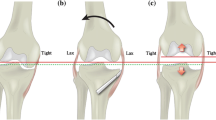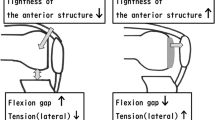Abstract
Purpose
Adjusting the soft-tissue balance during surgery is crucial in total knee arthroplasty (TKA). However, even using the gap technique, the expected tibial gap is sometimes not achievable. We developed a new method of proximal tibial cutting to acquire the expected tibial gap and insert a tibial liner of appropriate thickness.
Methods
This study included 128 patients who underwent medial pivot-type TKA for varus knee osteoarthrosis. After completion of the femoral cut using and removal of the bony spur at the medial tibia according to the preoperative plan, we inserted a trial femoral component to the distal femur. Applying valgus manual stress on the knee in extension, we measured the medial gap between the femoral trial and tibial plateau using calipers, defining this medial gap as “pre-gap”. A proximal tibial cut was made referring to the pre-gap in the pre-gap group (n = 64). We defined Δgap as the difference between the expected tibial liner thickness and the final tibial liner thickness during surgery. We compared Δgap between the pre-gap group and a control group with conventional tibial cutting without pre-gap measurement (n = 64).
Results
The frequency of an ideal tibial cut (Δgap = 0) was 82% in the pre-gap group and 61% in the control group. The frequency of outliers (Δgap ≥ 2 mm) was 4% and 18%, respectively. The expected tibial liner was selected more frequently in the pre-gap group than in the control group.
Conclusions
Our method was beneficial for acquiring the expected gap in extension to avoid an inadequate gap.
Level of evidence III
Case-control study.




Similar content being viewed by others
References
Ahn JH, Lee SH, Kang HW (2016) Quantification of the effect of vertical bone resection of the medial proximal tibia for achieving soft tissue balancing in total knee arthroplasty. Clin Orthop Surg 8:49–56
Babazadeh S, Stoney JD, Lim K, Choong PF (2009) The relevance of ligament balancing in total knee arthroplasty: how important is it? A systematic review of the literature. Orthopedic reviews 1:e26
Daines BK, Dennis DA (2014) Gap balancing vs. measured resection technique in total knee arthroplasty. Clin Orthop Surg 6:1–8
Huang T, Long Y, George D, Wang W (2017) Meta-analysis of gap balancing versus measured resection techniques in total knee arthroplasty. Bone Jt J 99-B:151–158
Scott RD, Chmell MJ (2008) Balancing the posterior cruciate ligament during cruciate-retaining fixed and mobile-bearing total knee arthroplasty: description of the pull-out lift-off and slide-back tests. J Arthroplast 23:605–608
Insall J, Easley H (2001) Surgical techniques and instrumentation in total knee arthroplasty. In: Surgery of the knee, 3rd edn. Churchill Livingstone, Philadelphia, pp 1553–1620
Minoda Y, Nakagawa S, Sugama R, Ikawa T, Noguchi T, Hirakawa M, Matsui Y, Nakamura H (2016) Decreased extension gap and valgus alignment after implantation of total knee prosthesis in primary varus knees. Knee Surg Sports Traumatol Arthrosc Off J ESSKA 24:3642–3647
Sugama R, Kadoya Y, Kobayashi A, Takaoka K (2005) Preparation of the flexion gap affects the extension gap in total knee arthroplasty. J Arthroplast 20:602–607
Berger RA, Rubash HE, Seel MJ, Thompson WH, Crossett LS (1993) Determining the rotational alignment of the femoral component in total knee arthroplasty using the epicondylar axis. Clin Orthop Relat Res 286:40–47
Griffin FM, Insall JN, Scuderi GR (2000) Accuracy of soft tissue balancing in total knee arthroplasty. J Arthroplast 15:970–973
Matsumoto T, Muratsu H, Kawakami Y, Takayama K, Ishida K, Matsushita T, Akisue T, Nishida K, Kuroda R, Kurosaka M (2014) Soft-tissue balancing in total knee arthroplasty: cruciate-retaining versus posterior-stabilised, and measured-resection versus gap technique. Int Orthop 38:531–537
Kadoya Y, Kobayashi A, Komatsu T, Nakagawa S, Yamano Y (2001) Effects of posterior cruciate ligament resection on the tibiofemoral joint gap. Clin Orthop Relat Res 391:210–217
Lombardi AV (2003) Soft Tissue Balancing of the Knee-Flexion. In: Callaghaen JJ (ed) The adult knee. Lipppincott Williams & Wilkins, Philadelphia, pp 1223–1232
Asano H, Muneta T, Hoshino A (2008) Stiffness of soft tissue complex in total knee arthroplasty. Knee Surg Sports Traumatology, Arthrosc Off J ESSKA 16:51–55
Tang Q, Yu HC, Shang P, Tang SK, Xu HZ, Liu HX (2017) Selective medial soft tissue release combined with tibial reduction osteotomy in total knee arthroplasty. J Orthop Surg Res 12:174
Moon YW, Kim HJ, Ahn HS, Park CD, Lee DH (2016) Comparison of soft tissue balancing, femoral component rotation, and joint line change between the gap balancing and measured resection techniques in primary total knee arthroplasty: a meta-analysis. Medicine 95:e5006
Funding
The authors declare that they did not receive and will not receive any benefits or funding from any commercial party related directly or indirectly to the subject of this article
Author information
Authors and Affiliations
Corresponding author
Ethics declarations
Conflict of interest
The authors declare that they have no conflict of interest.
Ethical approval
All procedures performed in studies involving human participants were in accordance with the ethical standards of the institutional research committee and with the 1964 Helsinki Declaration and its later amendments or comparable ethical standards.
Additional information
Publisher's Note
Springer Nature remains neutral with regard to jurisdictional claims in published maps and institutional affiliations.
Rights and permissions
About this article
Cite this article
Sekiya, H., Takatoku, K., Kanaya, Y. et al. New method for acquiring the expected extension gap in total knee arthroplasty. Eur J Orthop Surg Traumatol 30, 731–735 (2020). https://doi.org/10.1007/s00590-019-02612-2
Received:
Accepted:
Published:
Issue Date:
DOI: https://doi.org/10.1007/s00590-019-02612-2




